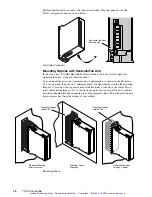
➀
Introduction
3
TQ10 Step & Direction Drive – Description & Block Diagram
The TQ10SD Step & Direction Drive is a servo drive designed to run three phase brushless
DC servo motors equipped with Hall effect sensors. It can also operate brushed DC servo
motors.
The block diagram for a typical system is shown below.
Indexer
Motor
Motor
Currents
Step
Pulses
High Level
Commands
Host Computer
or
Programmable
Controller
TQ10
Step & Direction
Servo Drive
Hall & Motor Temp
Signals
Encoder
Signals
TQ10SD Step & Direction Drive – Block Diagram
The host computer or programmable controller may or may not be necessary, depending
upon the motion controller’s capabilities.
There are two circuit boards inside the TQ10SD—a
control board
and a
torque drive
board
. The control board takes in control signals, and transforms them into a torque
command. The drive board takes the torque command, and produces motor current in an
amount proportional to the command.
The TQ10SD generates a move profile based upon step and direction signals from the
indexer. For each step pulse received, the drive will make the motor turn one encoder
count. Incoming step pulses represent
commanded position
, and go into one of the inputs of
a summing node. Incoming encoder counts represent
actual position
, and go into the other
input of the summing node. During a typical move, actual position will differ from com-
manded position by at least a few encoder counts. Actual position is subtracted from
commanded position at the summing node—the result is
position error
. The TQ10SD
produces an error signal, an analog voltage proportional to the error. The error signal is
modified by the PID control loop, then continues to the torque drive circuit board as a
torque command
. The torque drive board is the same board that is used in the TQ10 Torque
Drive; for a description of how the torque command is transformed into motor current, see
the previous section describing the TQ10 Torque Drive.
Other Features – TQ10 & TQ10SD
Dip Switches
The TQ10 Drive (the name TQ10 now refers to both drives) has 12 DIP switches on the top
and three DIP switches on the bottom. You can set these switches to configure the drive for
your particular application.
Inputs and Outputs
All input and output signal connections are made on the front panel of the drive, through
removable screw terminal connectors.
Artisan Technology Group - Quality Instrumentation ... Guaranteed | (888) 88-SOURCE | www.artisantg.com













































